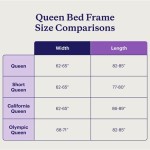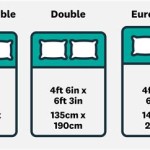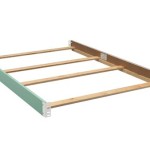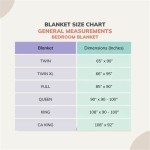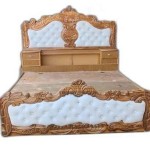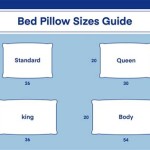Size Of Standard Queen Bed: A Comprehensive Guide
The standard queen bed size is a prevalent choice for bedrooms, offering a balance between space efficiency and sleeping comfort. Understanding the dimensions and suitability of a queen bed is crucial for informed decision-making during furniture selection and bedroom design. This article provides a detailed overview of the size of a standard queen bed, its advantages, considerations, and comparisons to other bed sizes.
The primary purpose of a bed is to provide a surface for rest and sleep. The size of the bed directly influences the quality of sleep and overall comfort. A bed that is too small can lead to restricted movement and disrupted sleep patterns, while a bed that is too large may unnecessarily consume valuable floor space. The standard queen bed attempts to strike a balance, providing sufficient space for individuals and couples without overwhelming smaller bedrooms.
Standard Queen Bed Dimensions
The universally accepted dimensions of a standard queen bed are 60 inches in width and 80 inches in length. This translates to 5 feet wide and 6 feet 8 inches long. These dimensions represent the sleeping surface of the mattress and do not include the frame, headboard, or footboard, which can add several inches to the overall footprint of the bed. These additional inches might vary significantly depending on the style and design of the bed frame.
It is essential to consider the thickness or height of the mattress when assessing mattress dimensions. A thicker mattress will add to the overall height of the bed, influencing the ease of getting in and out of bed. Mattress thickness can range from 8 inches to 14 inches or more in modern designs. The base of the bed frame and the thickness of the bedding will also further contribute to the overall visual profile of the bed.
Understanding the precise dimensions is crucial when planning bedroom layouts. Accurate measurements ensure the bed fits comfortably within the available space, leaving adequate room for movement and other furniture pieces. Failing to account for these dimensions during the planning stage can lead to inconveniences and necessitate furniture rearrangement or even necessitate selecting an alternative bed size.
Advantages of Choosing a Queen Bed
The queen bed offers numerous advantages that make it a popular choice for many homeowners. Its size provides a comfortable sleeping arrangement for both individuals and couples, offering ample space for movement during the night. This reduces the likelihood of disturbing a sleeping partner and contributes to a more restful sleep experience.
Another significant advantage is its suitability for a variety of room sizes. While a king-size bed may be too large for smaller bedrooms, a queen bed typically fits well in rooms that are at least 10 feet by 10 feet. This versatility makes it a practical choice for apartments, guest rooms, and master bedrooms that are not excessively large.
Queen-size beds also boast a wider availability of bedding options. A vast array of sheets, comforters, and other bedding accessories are readily available in queen sizes, offering consumers a greater selection of styles, materials, and price points. This ease of finding matching bedding contributes to the overall aesthetic appeal and convenience of owning a queen-size bed.
From an economic standpoint, queen-size beds strike a balance between comfort and affordability. They are generally less expensive than king-size beds, both in terms of the initial purchase price of the bed itself and the cost of accompanying bedding. This makes them an appealing option for budget-conscious individuals who still desire a comfortable and spacious sleeping arrangement.
Factors to Consider Before Purchasing
Before making a purchase, several factors should be taken into consideration to ensure the queen-size bed is the right choice. Room size is a primary consideration. Measuring the bedroom and carefully planning the layout is crucial to avoid overcrowding and ensure adequate space for movement. Bear in mind to factor in the dimensions of the bed frame and any headboard or footboard that will be attached.
The number of occupants is another important factor. While a queen bed is suitable for couples, individuals who prefer a considerable amount of space or who frequently share the bed with pets may find a king-size bed to be a more comfortable option. Personal sleep preferences, such as whether one tends to move around a lot during sleep, should also inform this determination.
Budget constraints also play a role in the decision-making process. Queen-size beds are generally more affordable than king-size beds, but the overall cost can vary depending on the quality of the mattress, the type of bed frame, and the bedding accessories chosen. Establish a realistic budget and explore different options within that range to identify the best value for the investment.
Accessibility and ease of movement within the bedroom are also crucial considerations. Ensure that there is sufficient space to walk around the bed comfortably and to open drawers and doors without obstruction. A cluttered or cramped bedroom can detract from the overall sense of relaxation and comfort. It's important to measure the size of the bed frame so that when the bed is in place, there is still room to walk around it without issue.
The intended use of the room should also be considered. If the queen bed is meant for a guest room, it is generally a suitable size. If it is meant for a master bedroom that sees extensive use, the occupants may prefer a larger bed to provide additional space and comfort, especially if they are used to sleeping on a larger bed.
Queen Bed Versus Other Bed Sizes
Comparing the queen bed to other common bed sizes can help clarify its advantages and disadvantages in different scenarios. The most common alternatives are twin, full, king, and California king beds. Each size offers distinct features and suitability for various needs and preferences.
Twin beds, measuring approximately 38 inches wide and 75 inches long, are the smallest standard bed size. They are typically used in children's rooms, dormitories, or small guest rooms. While space-saving, they are generally too narrow for adults or couples. The difference between the queen bed and the twin bed is significant, with the queen bed offering substantially more sleeping space.
Full beds, also known as double beds, measure approximately 54 inches wide and 75 inches long. They offer slightly more space than twin beds but are still relatively narrow for couples. A full bed may be an option for a single adult in a smaller room, but a queen bed generally provides a more comfortable and spacious sleeping arrangement. The queen bed is wider and longer than the full bed, offering an improved experience for single sleepers who enjoy moving around and for couples who don't require a king size.
King beds, measuring approximately 76 inches wide and 80 inches long, are the largest standard bed size. They offer ample space for couples and are particularly suitable for those who prefer a considerable amount of personal space or who have children or pets that frequently share the bed. However, their large size can make them impractical for smaller bedrooms. While a king bed offers more width, the queen bed offers a more balanced solution for many bedrooms.
California king beds, measuring approximately 72 inches wide and 84 inches long, are slightly narrower but longer than standard king beds. They are a good choice for taller individuals who need extra legroom. However, like king beds, they require larger bedrooms to accommodate their size. Consider a California king bed if the sleeper is particularly tall and the room size can accommodate the significant length required.
Ultimately, the choice of bed size depends on individual needs, preferences, and room dimensions. The queen bed offers a compelling balance between space efficiency and sleeping comfort, making it a versatile and popular choice for many homes. Comparing it to other bed sizes highlights its suitability for couples and individuals who desire a comfortable sleeping arrangement without the need for the larger footprint of a king-size bed.

Queen Size Bed Dimensions Compared To Other Sizes Eachnight

Queen Size Bed Dimensions Guide Dreamcloud

Mattress Sizes Chart And Bed Dimensions Guide Amerisleep

Difference Between Full And Queen Mattresses Texas Mattress Makers

Bed Sizes Guide Curtain Of Maine

The Official Organic Mattress Size Guide 2025 Edition

Which Mattress Size Should I Get Texas Makers

Mattress Size Guide Secrets For Every Room Eachnight

Mattress Sizes Chart Bed Dimensions Guide Purple

Us Bed Sizes Chart Dimensions

